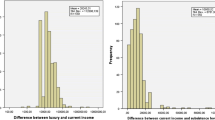Abstract
The procedures used in cost utility analysis for eliciting quality of life weights have generally omitted any instruction concerning the level of consumption in a health state, despite the fact that some health states preclude the possibility of normal employment. This introduces ambiguity into the interpretation of quality of life (QoL) scores, and project ranking is sensitive to the subsequent treatment of consumption in the analysis. This article reports the results of a study that questioned 131 respondents to a time trade-off (TTO) interview about their assumptions concerning consumption and the amount of thought given to consumption. Results indicate that, without prompting, most assumed unchanged consumption, implying little bias in existing studies.
Similar content being viewed by others
Notes
The conclusion by Weinstein et al. would be correct if QALYs were (should be) monetised in a way that resulted in the perfect (market) valuation of QALYs. In this case if DC = direct cost, the net cost per QALY (excluding consumption), i.e., (DC − C)/(QALY − C), and the full direct cost per QALY assuming consumption, i.e., DC/QALY, would result in the same net present value (DC − QALY) where QALYs subsume consumption. However, as illustrated in Table 4, this result breaks down when QALYs are not measured in this way.
With QALYs valued at $800 the QALY gains from service A and service B would be 0.4 + 80/800 = 0.5 and 0.1 + 100/800 = 0.225, respectively. If procedures 1 and 2 were used, the net present value of the services would be $400 and $180, respectively.
Illustrating this, in the previous arithmetic example (footnote 3), the QALY value of service A would exceed 1.00 after treatment.
References
Brouwer, W.B., Koopmanschap, M.A.: On the economic foundations of CEA. Ladies and gentlemen, take your positions! J. Health Econ. 19, 439–459 (2000)
Brouwer, W.B., Koopmanschap, M.A., Rutten, F.F.: Productivity costs means through quality of life? A response to the recommendation of the Washington Panel. Health Econ. 6, 253–259 (1997)
Brouwer, W.B., Koopmanschap, M.A., Rutten, F.F.: Productivity costs in cost-effectiveness analysis: numerator or denominator: a further discussion. Health Econ. 6, 511–514 (1997)
Brouwer, W.B., Rutten, F.F.: The missing link: on the line between C and E. Econ. Eval. 12, 629–636 (2003)
Dowie, J.A.: Valuing the benefits of health improvement. Aust. Econ. Pap. 9(14), 21–41 (1970)
Gold M.R., Siegel J.E., Russell L.B., Weinstein M.C.: Cost effectiveness in health and medicine. Oxford University Press, Oxford (1996)
Hawthorne, G., Richardson J, Day, N.A.: A comparison of the assessment of quality of life (AQoL) with four other generic utility instruments. Ann. Med. 33(5), 358–370 (2001)
Johannesson M.: Avoiding double counting in pharmacoeconomic studies. Pharmacoeconomics 11, 385–388 (1997)
Johannesson, M., Karlsson, G.: The friction cost method: a comment. J. Health Econ. 16, 249–256 (1997)
Koopmanschap, M., Rutten, F.F., van Ineveld, B.M., van Roijen L.: The friction cost method for measuring indirect costs of disease. J. Health Econ. 14, 171–189 (1995)
Krol, M., Brouwer, W., Sendi P.: Productivity cost in health state valuations: does explicit instruction matter. Pharmacoeconomics 24(4), 401 (2006)
Meltzer, D., Weckerle C., Chang, L.M.: Do people consider financial effects in answering quality of life questions. Med. Decis. Making 19, 517 (1999)
Misajon, R., Hawthorne, G., Richardson, J., Barton, J., Peacock, S., Iezzi A., Keeffe J: Vision and Quality of Life: The Development of a Utility Measure. Invest. Ophthalmol. Vis. Sci. 46, 4007–4015 (2005)
Myers, J., McCabe, S., Gohmann S: Quality-of-life-assessment when there is a loss of income. Med. Decis. Making, 27, 27–33 (2007)
Olsen, J.A., Richardson J.: Production gains from health care: what should be included in cost-effectiveness analyses? Soc. Sci. Med. 49, 17–26 (1999)
Peacock, S., Misajon, R., Iezzi, A., Richardson, J., Hawthorne, G., Keeffe J.: Vision and quality of life: development of methods for the VisQoL vision related utility instrument. Ophthalmic Epidemiol. (2008, in press)
Richardson, J.: Economic assessment of health care: theory in practice. Aust. Econ. Rev. 1, 4–21 (1991)
Richardson, J., Day, N.A., Peacock, S., Iezzi, A.: Measurement of quality of life for economic evaluation and the assessment of quality of life (AQoL) mark II instrument. Aust. Econ. Rev. 37, 62–88 (2004)
Sendi, P., Brouwer, W.B.F.: Is silence golden? A test of the incorporation of the effects of ill-health on income and leisure in health state valuations. Health Econ. 14, 643–647 (2005)
Weinstein, M.C., Siegel, J.E., et al.: Productivity costs, time costs and health related quality of life: a response to the Erasmus group. Health Econ. 6, 505–510 (1997)
Acknowledgements
Stuart Peacock is a scholar of the Michael Smith Foundation for Health Research. The views expressed in this paper are solely those of the authors.
Author information
Authors and Affiliations
Corresponding author
Rights and permissions
About this article
Cite this article
Richardson, J., Peacock, S.J. & Iezzi, A. Do quality-adjusted life years take account of lost income? Evidence from an Australian survey. Eur J Health Econ 10, 103–109 (2009). https://doi.org/10.1007/s10198-008-0107-4
Received:
Accepted:
Published:
Issue Date:
DOI: https://doi.org/10.1007/s10198-008-0107-4




